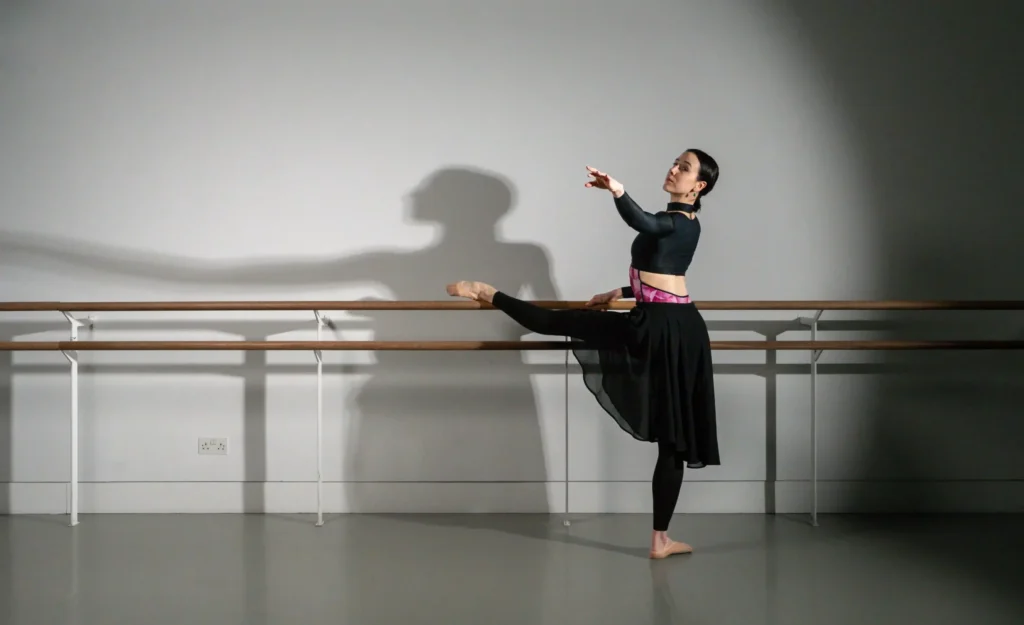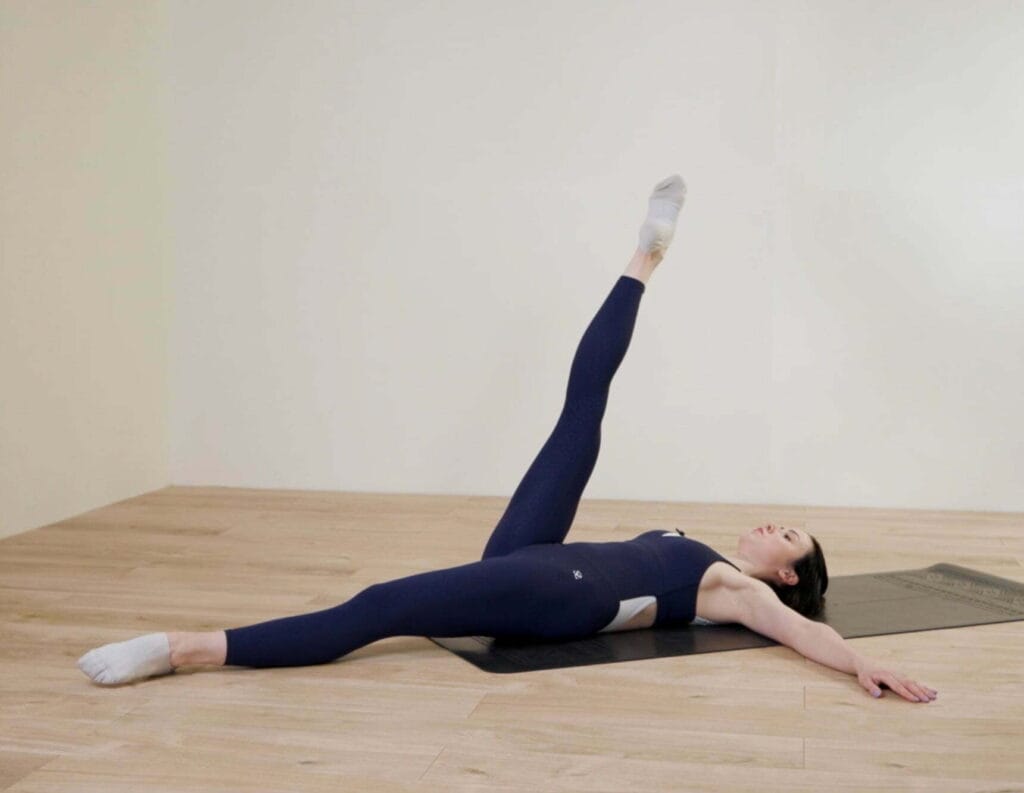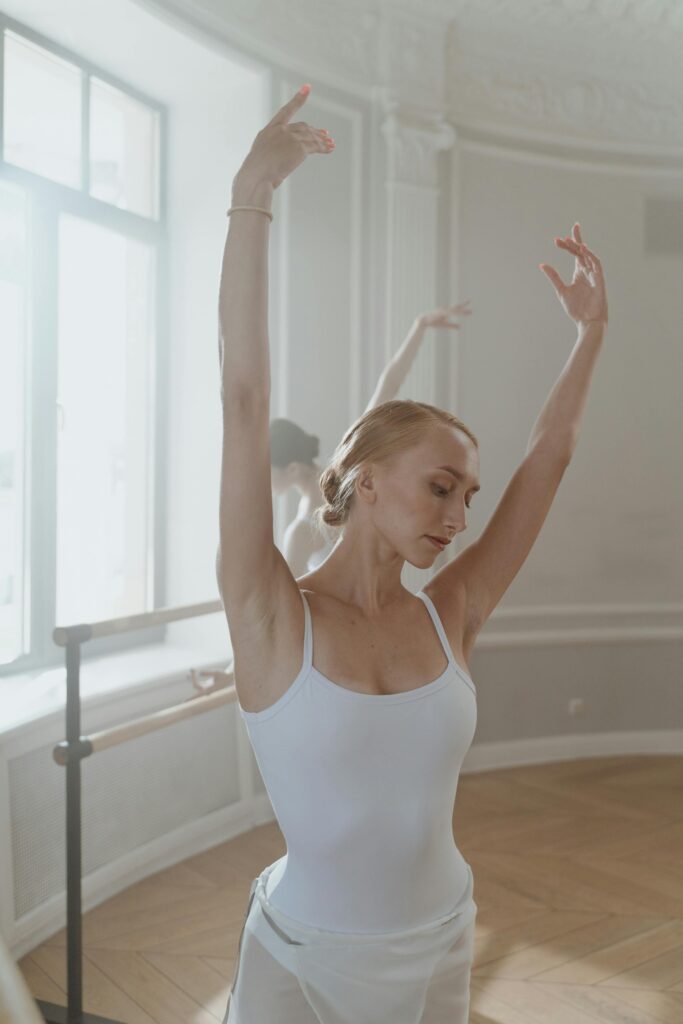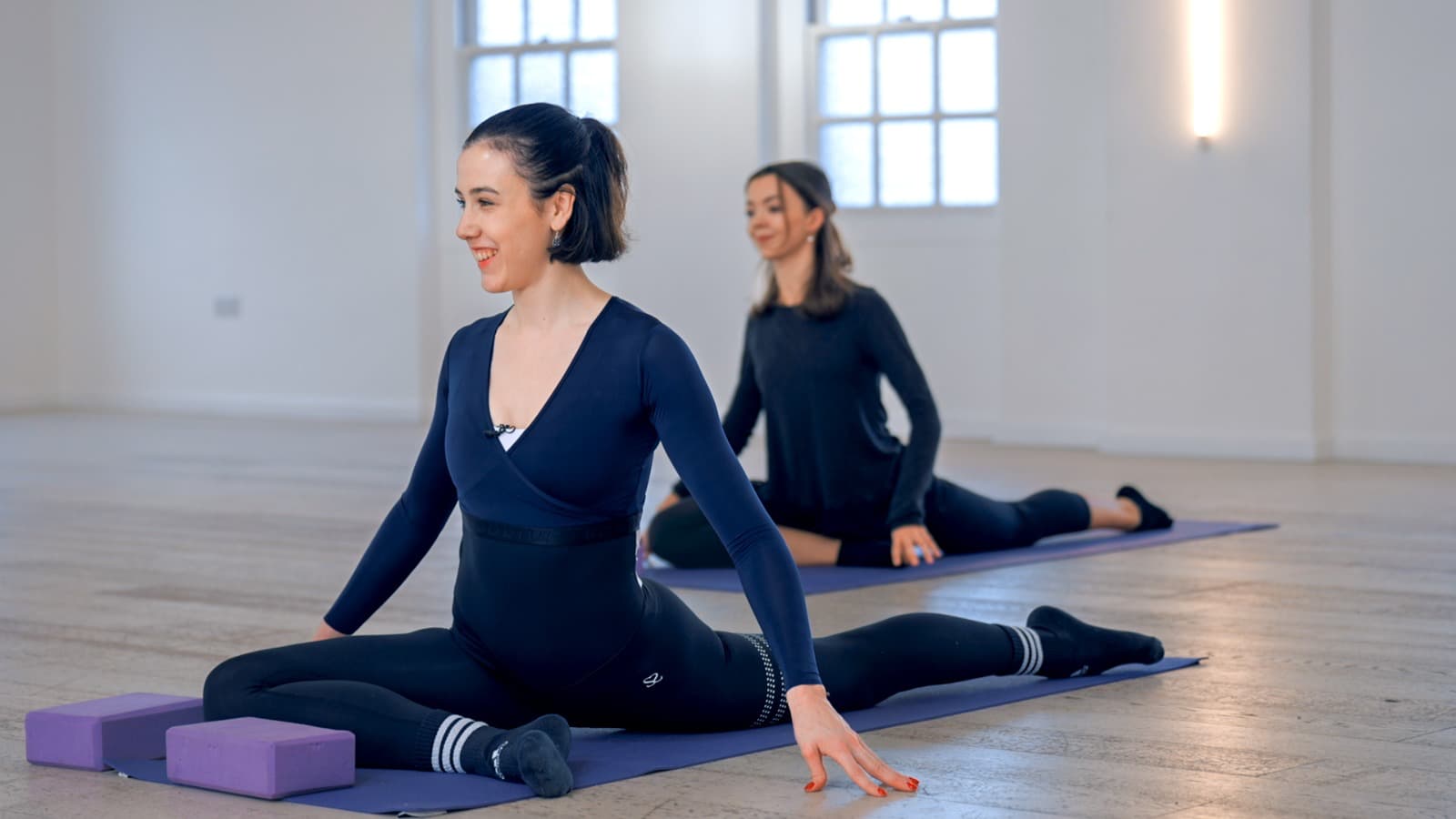Ballet is often described as a beautiful, graceful dance form that seems to defy gravity. At the heart of this ethereal art lies the spine – a central pillar that not only provides support but also serves as the source of ballet dancers’ incredible mobility and fluidity. In the world of ballet, the spine’s role is nothing short of pivotal, and our ballet studio and online classes (available on our affordable soloist membership plan) are here to help you unlock its superpowers.
In this article, we’ll explore the importance of a flexible and strong spine for ballet dancers, delve into the potential injuries that may arise from a stiff spine, and highlight the intricate connection between the core and the spine. Plus, we’ll provide you with a set of the best mobility exercises as well as online back flexibility classes tailored to enhance your back flexibility and improve your ballet skills.
The spine: A dancer’s true superpower
When we think of ballet, our minds often conjure up images of exquisite leaps, graceful pirouettes, back bends and stunning arabesques. Each of these awe-inspiring movements is intricately connected to the spine’s range of motion. In fact, the spine acts as a dancer’s true superpower, allowing for the fluid execution of even the most complex ballet moves.
- Arabesque: This iconic ballet pose, where one leg extends straight behind while the upper body arches forward, is a testament to the spine’s flexibility. A supple and strong spine allows the dancer to create a stunning line, with the back leg soaring effortlessly.
- Grand Pas de Chat/Grand Jete: These breath-taking leaps require not only powerful leg work but also a strong and flexible spine. A mobile spine ensures that the dancer can arch their back, extend their legs, and land with grace, making these jumps appear as if they are defying gravity.
The importance of a flexible and strong spine
So, why is it crucial for ballet dancers to have a flexible and strong spine? The answer lies in the very essence of ballet itself. Ballet is all about achieving the perfect balance between strength and grace, and the spine plays a pivotal role in maintaining that equilibrium. Here’s a very useful, expert-led online ballet workout designed to build strength in your back, as well as some of the benefits of doing these workouts, which include:
- Enhanced range of motion: A flexible spine allows ballet dancers to move with greater ease and fluidity. The ability to arch, curve, and extend the spine helps in achieving those beautiful lines and shapes that are synonymous with ballet.
- Injury prevention: A stiff spine can lead to an array of injuries, hampering a dancer’s career and causing pain and discomfort. A lack of mobility in the spine can result in strained muscles, stressed ligaments, and even fractures in extreme cases.
- Better balance: Balance is at the core of ballet, and a strong spine contributes significantly to a dancer’s stability. A well-aligned spine helps in maintaining proper posture and balance, ensuring that the dancer can execute moves with precision and confidence.
The core-spine connection
To fully understand the importance of the spine in ballet, it’s essential to recognise its intimate connection with the core muscles. The core, which includes the muscles of the abdomen, lower back, and pelvis, serves as the central stabilising force for a dancer’s body. It works in tandem with the spine to maintain balance, support movement, and protect against injuries, which is why our members find our Ballerina Core class, Floor Barre class, and Balance Course so useful!
- Alignment: The alignment of the spine is heavily influenced by the strength and engagement of the core muscles. A strong core helps maintain proper spinal alignment, reducing the risk of misalignments and injuries.
- Posture: The core muscles play a significant role in maintaining good posture. When the core is weak or underutilised, a dancer may slouch or have an imbalanced posture, which can lead to spine-related issues.
- Force transfer: Ballet movements often involve transferring force from the lower body to the upper body and vice versa. A strong core acts as a bridge, facilitating the smooth transfer of force and ensuring that the spine remains stable and protected.
Here is a fantastic back workout program designed for ballet dancers from our online studio that you can try at home!
Unlocking Your Spine’s Superpowers: Mobility Exercises
Now that we’ve established the spine’s critical role in ballet and the potential consequences of neglecting its mobility, it’s time to unleash your spine’s superpowers. Here is a great spine flexibility workout class for you to do at home, as well as some of the most effective mobility exercises tailored specifically for ballet dancers:
The best spinal flexibility exercises for dancers
Try out our online spinal mobility class or incorporate the following exercises into your regular routine:
- Cat-Cow Stretch: Begin on your hands and knees, arching your back like a cat (cat pose) and then extending your spine, lifting your head and tailbone (cow pose). Repeat this motion slowly for several rounds.
- Backbends: Stand with your feet hip-width apart, place your hands on your lower back, and gently arch backward, opening up the chest and allowing your spine to bend. Support yourself with your hands as needed.
- Twists: Sit cross-legged or on your heels and gently twist your torso to the left and right, keeping your spine long. Hold each twist for a few breaths, feeling the stretch along your spine.
The best core-strengthening exercises for dancers
Try out our core strengthening online class or incorporate the following exercises into your regular routine:
- Planks: Begin in a push-up position, but with your forearms on the ground. Hold this position, engaging your core muscles, and keeping your body in a straight line from head to heels.
- Leg raises: Lie on your back with your arms at your sides. Lift your legs a few inches off the ground, engaging your lower abdominal muscles and keeping your spine flat on the mat. Breathe out as you lower your legs back down (slowly and with control) without letting them touch the floor, breath in as you raise them back up, and repeat.
- Pilates hundreds : Lie on your back with your spine flat on your mat, lift your legs off the ground, and pump your arms up and down in small, controlled motions while engaging your core. Aim for 100 arm pumps.
The best stretching exercises for your spine
Try out our online stretching class or incorporate the following exercises into your regular routine!
For beginners:
- Child’s Pose: Kneel on the ground and sit back on your heels. Extend your arms forward on the floor and lower your forehead to the ground. Create a bilateral stretch by pulling the back of your body towards your heels while extending the front of your body towards your hands. This gentle stretch helps release tension in the spine and lower back.
- Seated forward bend: Sit with your legs extended straight in front of you. Reach forward, trying to touch your toes or ankles while keeping your spine lengthened. Don’t curve your spine forward – instead, only hinge at the hips and move your chest forward and down towards your legs.
- Spinal rotation stretch: Sit with your legs crossed. Twist your torso to the right, placing your left hand on your right knee and your right hand behind you. Breathe out to relax into the stretch, and breathe in to lengthen your spine. Repeat on the other side.
For intermediate and advanced dancers:
- Upward facing dog: Begin by lying face down on your yoga mat, with your legs extended behind you and the tops of your feet resting on the mat. Place your hands on the mat, close to your ribcage, with your fingers pointing forward. Your elbows should be bent. Inhale deeply as you press through your hands, lifting your chest off the mat while keeping your hips and legs in contact with the floor. Engage your leg muscles and press the tops of your feet firmly into the mat. Gently lift your chin and look forward, keeping your neck long and in line with your spine. Hold this position for a few breaths, feeling the stretch in your abdominal muscles, and opening up your chest. Exhale as you slowly lower your chest back down to the mat, returning to the starting position.
- Straddle and side bend stretch: Sit on the floor with your legs extended straight in a wide straddle position, forming a V shape. Shift your weight to one side, bending your torso sideways toward that leg. Reach your arm on the same side as your bent leg towards your foot. Your opposite arm can rest on the floor for support. Feel the stretch along the side of your back and through your oblique muscles. Keep both hips grounded on the floor. Hold the stretch for 20-30 seconds while taking deep, slow breaths. Try to deepen the stretch slightly with each exhalation. Slowly return to an upright position and repeat the stretch on the other side.
- Crab: Sit on the floor with your knees bent and feet flat on the ground, hip-width apart. Place your hands behind you with your fingers pointing away from your body, palms flat on the ground. Press through your hands and lift your hips off the ground, coming into a reverse tabletop position. From the reverse tabletop position, exhale and slowly lower your hips down while bending your elbows, bringing your head and chest towards the ground in front of you. Inhale and reverse the movement. Press through your hands to straighten your arms, lifting your head and chest upward, arching your back. Your hips should now be off the ground, creating a “crab” shape. Continue this push-up to arch motion for a few repetitions, coordinating your breath with the movement. When you’re finished, slowly lower your hips back down to the ground and release the arch to return to the starting position.
To help release and strengthen your back muscles, we also highly recommend that you try out this expert-led spine stretching class for the best results.
In the world of ballet, where grace meets strength, the spine’s role is an essential one. It serves as the backbone of every breath-taking leap, every exquisite arabesque, and every graceful pirouette. A flexible and strong spine is the key to unlocking your full potential as a ballet dancer, enhancing your range of motion, preventing injuries, and ensuring impeccable balance.
As you embark on your journey to unleash your spine’s superpowers, remember that it’s not only about the spine but also about the core. The core-spine connection is the cornerstone of stability and balance in ballet. Strengthening your core muscles will not only protect your spine but also elevate your overall performance.
So, embrace these mobility exercises as your daily practice, and watch your spine and core transform. With dedication and persistence, you’ll find yourself gliding through your practice with a spine that’s both strong and supple, embodying the true essence of ballet’s beauty and grace.
Improve your back flexibility with online classes from a leading UK ballet studio
Develop back and spinal flexibility with expert guidance at Ballet with Isabella!
Whether you’re a beginner or advanced dancer, our online ballet studio classes are designed to maximise your potential. You’ll get expert guidance as each class is designed and led by Isabella McGuire Mayes, the first British graduate of The Vaganova Ballet Academy and soloist of The Mikhailovsky Ballet.
Explore our range of classes, from HIT and core workouts to precise poses and movements. Beyond online classes that you can do on your own schedule, we offer live online classes, private lessons, plans, and the option for in-person workshops and coaching sessions.
Together, we can develop your back flexibility and spinal mobility – and take your ballet journey to new heights! Visit our online studio to select a plan that suits your level and needs, and sign up for our affordable soloist membership.




